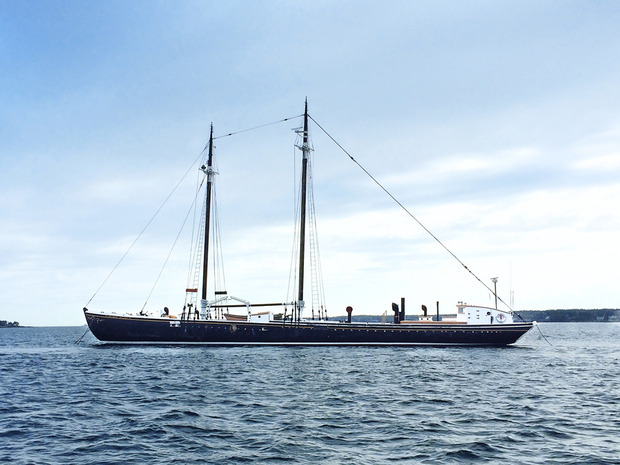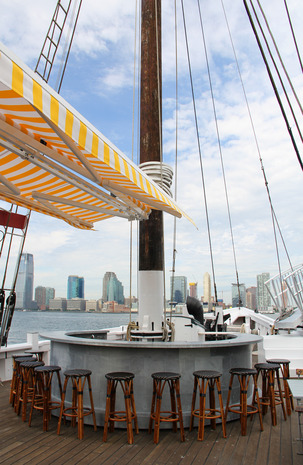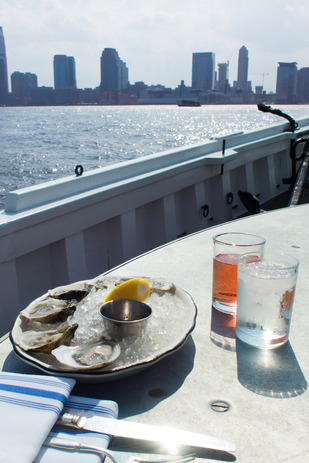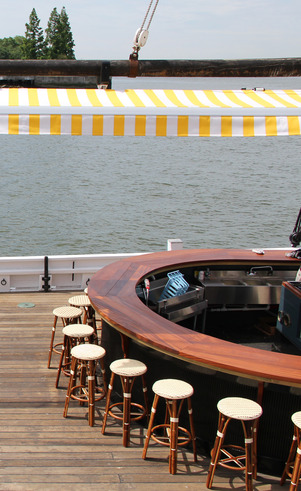Grand Banks Floating Oyster Bar
The historic Sherman Zwicker schooner finds extended life on Manhattan’s Hudson River waterfront


As of this week, Manhattan has a new maritime attraction in the form of the Grand Banks, a working historic schooner turned seasonal oyster bar. Though the brief may be appetizing enough as is, the allure of the 72-year-old Sherman Zwicker extends far beyond its culinary offerings, as it stands to host art exhibitions and an onboard lecture series on topics from seafaring culture to aquatic sustainability.
The project itself is an impressive collaboration between the Maritime Foundation—which currently oversees the continued preservation of the Sherman Zwicker—and a handful of maritime enthusiasts, most notably Atlantic Yachting founders Alexander and Miles Pincus, revered restauranteur Mark Firth (co-founder of Brooklyn’s Diner and Marlow & Sons) and architect and interior designer Eric Cheong, who also happens to be the current studio director of Atelier Ace and former design studio manager of Roman and Williams. Needless to say, Grand Banks is no corny tourist trap; each and every detail of the project has been considered many times over.

“This project is like a merger of everything perfect that I love: working with friends, supporting a project that brings more awareness of maritime history and fishery conservations, and also just creating a great destination in Manhattan that is unique, but has a very pragmatically educational component to it too,” says Cheong, who lead the project’s design.
The Sherman Zwicker itself was built by hand of timber from the Pacific Northwest in 1942 in Lenenburg, Nova Scotia, and remains the last surviving saltbank fishing vessel in existence. Recently restored, the schooner itself is a museum-quality example of traditional boat-building, and the largest wooden vessel in NYC. Add in the current “Zwicker History” art installation exhibit in the ship’s original fish hold below deck, and the Sherman Zwicker becomes in essence an inanimate ambassador for maritime history and preservation of national treasures.


Though each notable name involved brings plenty of anecdotal experience—from being sailors and experts in their respective fields—turning the 142-foot vessel into a viable commercial enterprise proved a novel undertaking altogether. Cheong saw the vessel’s unique needs as an opportunity to explore, and problem-solve: “Constrained context is the best way to push the boundaries in design.” Everything from the way the structure and materials interact with the sun, water, wind and movement had to be considered. The main cocktail and beer bar was finished in tropical hardwoods with refined brass detailing, whereas the oyster bar was constructed entirely of zinc, a nautical material that’s rarely seen in such a context.
Much of the design detailing was meant to both respect and match the vessel’s original aesthetic, and reset any unflattering preconceived notions of what people may think of when they hear floating oyster bar. “You’ve seen boats that’ve been converted into restaurants and they just look like someone took a restaurant and put it on a boat,” says Cheong, “And we want it to feel like this boat could, and will, sail and move with these bars—they’re part of the functional architecture of the boat.”


By quenching both a literal and educational public appetite, Cheong and the Grand Banks partners hope to prove the concept of using commercial activity to preserve and bolster culturally relevant relics and historical landmarks as not only feasible but one that could and should be explored more in the future. “There are so many historical assets that are parts of ancient culture (to our society now) that are not used but still important. And the exciting part is there are so many opportunities like this to respect and keep these pieces alive,” says Cheong.
The Sherman Zwicker will remain moored on the southwest edge of Hudson River Park’s Pier 25 in Tribeca through October 2014, at which point it will sail south to an unannounced warmer climate for the winter. To learn more about the history of the vessel, and see about hours of operation visit Grand Banks online.
Lead and oyster image courtesy of Grand Banks, all others by Graham Hiemstra












